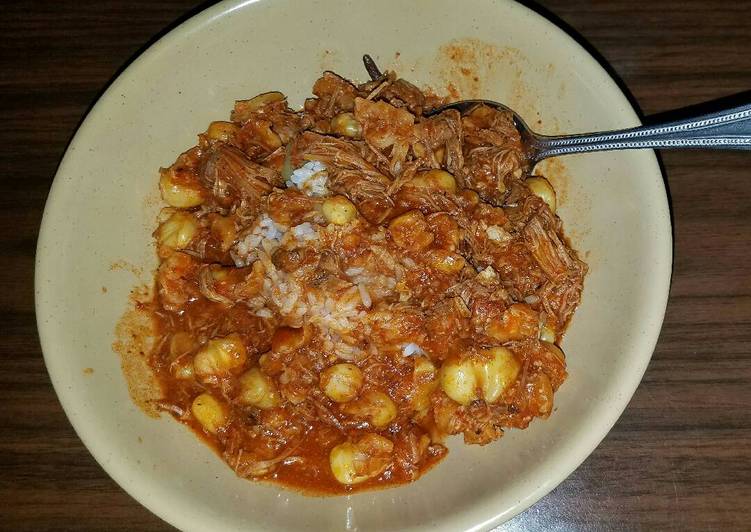Recipe: Tasty Pozole (Mexican Hominy Stew)

Recipe: Tasty Pozole (Mexican Hominy Stew) Delicious, fresh and tasty.
Pozole (Mexican Hominy Stew). Pozole is a super easy and amazingly tasty stew made with pork, dried chiles, and hominy. This recipe for the traditional Mexican stew is a pozole rojo and features red chile peppers. To some, this soup is at its best thanks to the garnishes, which provide balance and flavor in addition to decoration.
This hominy-studded stew is well known as a cure for hangovers and is often eaten in the wee hours of the morning as a preventive.
Pozole Blanco (White pozole) : Pozole varies according to region, but the above recipe is the most basic and is known as pozole blanco.
I've learned this recipe from a friend from Mexico.
You can have Pozole (Mexican Hominy Stew) using 10 ingredients and 9 steps. Here is how you cook that.
Ingredients of Pozole (Mexican Hominy Stew)
-
You need 1.5 of # Pozole (Hominy) may be canned or fresh most often found in Latin Stores.
-
You need 1.5 of # Pork Butt (Boston Butt) or other suitable Port Roast cut in large chunks (2 in.).
-
You need 1.5 of # Pork Belly cut in large chunks (2in.).
-
It’s 10 of large Dried Chiles (Guajillo, New Mexico).
-
Prepare 1 of Yellow or White Onion stuck with 2-4 whole cloves.
-
It’s 1 Tbsp of +/- Garlic.
-
You need 1 of Bay Leaf.
-
Prepare 2 tsp of Toasted Cumin Seeds (important to toast them).
-
Prepare of Salt and Pepper.
-
It’s of Lime wedges, Finely Chopped Onion, Chopped Cilantro, Oregano for garnish.
I don't eat menudo, because the tripe or pig's feet made me nauseous.
She always celebrated with this soup and I can eat everything in it without being grossed out!
It's very delicious and everyone always get seconds or thirds!
This delicious, hearty and flavorful meal has been enjoyed for centuries, and it comes with a shocking history.
Pozole (Mexican Hominy Stew) step by step
-
If using fresh Hominy (Pozole), soak overnight as you would dried beans if you want. If using canned Hominy, skip to step 3. I have to say either Pozole works, but fresh gives that "authentic" flair..
-
Drain the hominy and put in a large "caldero" or soup pot. Cover with water and bring to a boil. Let simmer briskly for 1 hour..
-
During Hominy cooking, toast Chiles in skillet or grill top taking care not to burn and develop a really off flavor. After, slit lengthwise and remove stems and seeds..
-
Place Chiles in pot with 4 cups of water, simmer 30 minutes and allow to cool. Blend to a paste using some of the water you simmered with making a consistency of roughly pancake batter..
-
Season Pork Belly and Shoulder with Salt and Pepper. I prefer to sear (Brown) the Shoulder, but the choice is yours. Either way, after Pozole has been cooking 1 hour, add the Pork Belly and Shoulder to the pot. Add the Onion with Cloves, Toasted Cumin Seeds, Bay Leaf and Garlic..
-
Cover with enough water 2 inches, then bring back to a brisk simmer. Top with water occasionally and taste broth for salt, simmer for about 2 1/2 hours more, meat should be tender and pozole grains should have softened and burst. Skim fat from surface if desired..
-
Add 1 cup chile purée and simmer for 10 minutes. Taste and correct seasoning. Add more purée if desired..
-
When serving, put pozole, meat and broth into big bowls. Garnish with pieces of thinly sliced cabbage, diced onion, lime wedges, cilantro and oregano as desired..
-
In my pic, I had White Rice left over so I just served over that. I KNOW….2 starches…..sue me!.
The main ingredient in Pozole is Hominy, which is made from corn.
Due to the belief that humans were made by the corn gods, in Mexican Aztec history.
If you've ever cooked that great Rick Bayless recipe for pozole verde, the Mexican meat and hominy soup flavored with green chilies and tomatillos, you'd know that it's a beast.
The truth is, unless you've got the day off, cooking pozole on a Thursday is nothing more than a sueño imposible.
Pozole is easily one of Mexico's most iconic and beloved dishes, but where does it originate and why does no one pozole taste like another?

